Forests
A forest is an area of land dominated by trees. Hundreds of definitions of forest are used throughout the world, incorporating factors such as tree density, tree height, land use, legal standing, and ecological function.
In Palestine, the responsibility for forest management falls on the Palestinian Ministry of Agriculture. According to the latest statistics of the Ministry of Agriculture, the number of forests currently in existence is 115 forests. The area allocated to forests in 1970 amounted to 318,137 dunums, and by 2018 it had declined, bringing the forest area to 246,592, as these areas include natural forests, cultivated forests, and areas barren (registered forests), but aerial photographs of the forests in 2007 showed that the area of forests covered with trees is only 85,500 dunums.
Types of forests in the Palestinian territories
1. Mobile Sand dunes mixed forest (Planted and Natural): the natural tree and shrub species of these forests is Artemisia monosperma, Atriplex halimus, Tmarix galica, and Retam raetam, about 70% of the cultivated species are Acacia cynophylla and Kenya.
2. Planted coniferus forest: The most important species planted in this forest is the Aleppo pine (Pinus halepensis) (more than 80% of the forest), followed by Pinus brutia, then Pinus pinea and Cupressus sempervirens. Kenya have been cultivated in wetlands. In the semi-coastal areas and the western slopes, due to the relative warmth, Pinus canarensis and Acacia cynoflata have been cultivated in it. After the year 2000, forest planting began to take into account biodiversity and planting natural trees, such as Arbatus andrachn, Laurus nobilis, Crataegus azarolus Crataegus oriana, Rhus coriaria, Pistacia palaestina, Pistacia atlantica, Querucus calliprinos, and Querucus biosseri.
3. Scelrophyllons Oak Forst and Maquis: Querucus calliprinos constitutes about 50% of the vegetation cover of these forests and divided into:
A. Semi-coastal oak forest: In addition to oaks, this forest is unique in the presence of some Buckthorn trees (combo) Zizyphus Spina christ- and Querucus inthaburensis also contains a high levels of Pistacia lentiscus and Ceratonia siliqua and some species like Phillyria media as well as Styrex officinalis and Rhamnus alaternus
B. Western mountain slopes forest: This forest grows at an altitude ranging between
250 – 600 m above sea level and is characterized by the beginning of the growth of Arbatus andrachne, Pistacia palaestina, Crataegus Oriana, Rhus coriaria, and Laurus nobilis, in addition to other trees like carob, cypress and styrax
C. High mountain forest: This forest is located at an altitude of more than 700 meters above sea level. In addition to Querucus calliprinos there is growth for other species like Querucus biosseri, Crataegus azarolus, Querucus inthaburensis Styrex officinalis, Rhus coriaria, Rhamnus alaternus, Pistacia palaestina and Ceratonia siliqua.
D. Eastern slopes Forest: This forest is found at an altitude ranging between 400-700 meters. The trees and shrubs of this forest are few compared to the forests of other regions Like Pistacia atlantica Rhamnus palaestinus, Ceratonia siliqua, Pistacia lentiscus and Styrex officinalis. The components of this forest are accompanied by white hawthorn and styrax trees.
4. Carob Lentisk Maguis forest: The presence of this forest is limited to the eastern slopes of the mountains of northern Palestine (Tubas Governorate and eastern Nablus Governorate) between 600 and 250 m above sea level. The tree and shrub vegetation of this forest is limited to Pistacia lentiscus and carob trees (carob trees do not exceed 1-3 trees per dunum) in addition to many types of Batha stunted shrubs.
5. Deciduous Thermoophilous Scrub: This forest is limited to the east of Tubas Governorate (at an altitude of less than 250 m above the ground the sea). This shrubby forest consists mainly of jujube (cedar or deciduous) shrubs and Retama raetam and Zizyphus lotus shrubs which are not higher than 2m.
6. Jordan River Riparian Wood: The presence of this forest is limited to both banks of the Jordan River on the western side (Palestine) and the northern side (Jordan) between 100 to 400m below the sea level. The vegetation cover of this forest consists of: Cyperus papyrus, Cyperus rotundus, Juncus arabicus, Phragmites australis, Lyciun earopaeum, Tamrix jordanica, Asparagns palaestinus, Atriplex halimus, Alhagi maurorum, Prosopis farcta, Palanites aegyptiaca, ،Zizyphus spina-christi, Salvadora Persica.
7. Halophytic forest: There are remains of it on the northwestern shore of the Dead Sea in the Ain Fashkha Nature Reserve, where its shrubby vegetation is formed according to its proximity to the sea, as follows: Tamarix tetragyna, Tamarix deserti thin Nitraria retus.
Sources are statistics from the Palestinian Ministry of Agriculture and Abu Ayyash et al., (2007)
